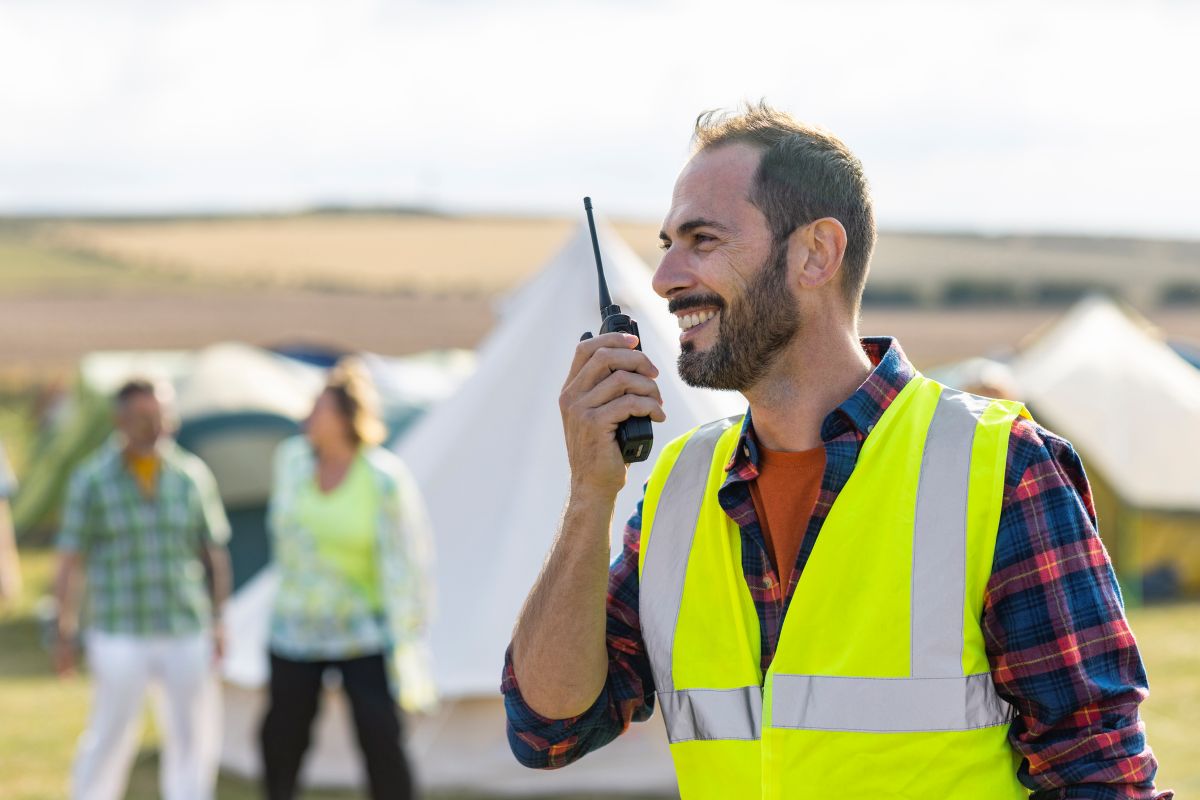Demonstrating a Commitment to Stewardship, Care, and Preparedness
Ministries must prioritize the safety of their congregations amid unforeseen challenges. While we serve as places of worship and community, we are not immune to risks like medical emergencies, natural disasters, or acts of violence. A dedicated church safety and security team ensures preparedness, demonstrating stewardship and care while keeping the ministry a secure haven for all.
Why Church Safety Teams Are Crucial For Ministries
Ministries host various events that bring diverse groups together, increasing the potential for crisis. A well-trained church safety and security team is essential for handling medical emergencies, crowd control, and potential threats − especially given the rise in violent attacks on houses of worship.
The Family Research Council (FRC) reports there were 436 documented acts of hostility against U.S. churches in 2023, more than double the 195 recorded in 2022 and nearly ten times the number from 2018. These incidents highlight the need for proactive preparedness and training. Assuming “it could never happen here” is not an option.
Beyond physical safety, a church security team fosters peace of mind, allowing worshippers to focus on faith and fellowship without distraction.
Selecting And Vetting Safety & Security Team Members
The success of a safety and security team depends on the quality of its members. Selecting the right people is a critical step.
Key Qualities to Look For in Ministry Safety Team Members:
- Commitment to the Ministry’s Mission: Team members should have a strong connection to the ministry and understand that their role is one of service and care. Ministries are typically open, inviting, welcoming places that should not resemble TSA checkpoints. While there can be situations that require a “warrior” mindset, someone with a “guardian” mindset − yet capable of becoming a “warrior” if needed − is a more suitable choice for the team.
- Calm Under Pressure: Emergencies often require quick, level-headed responses and sound decision-making. Take care to select individuals who can bring calm to chaotic situations.
- Integrity and Discretion: Safety and security roles often involve handling sensitive situations or even finances; trustworthiness is an essential trait.
- Relevant Skills, Experience, and Faith-Based Values: Do not discount candidates with no prior law enforcement or security experience. While a background in law enforcement, fire service, emergency medical service or healthcare, emergency management, or military service is certainly beneficial, such experience is not necessarily mandatory. Character, traits, coachability, and a servant’s heart are more important. There is room on a safety team for competent lay individuals who can serve in forward-facing positions where they will be the eyes and ears that first detect when something is amiss.
- Known Entities: Encourage known, trusted, reliable current team members to identify others they know to join the team. Open “cattle calls” sometimes lead to some very incompatible candidates stepping forward. While they may, of course, be redirected to more suitable ministries, consider that a personal invitation by a current team member who knows the qualities required to serve on the team may yield a more compatible pool of candidates. And just because someone has not previously expressed an interest in serving on the safety and security team does not mean they are uninterested. Often, people simply don’t know there’s a need or haven’t been asked.
Screening and Background Checks for Your Church Safety Team:
A comprehensive background check for Safety and Security Team candidates should include:
- a comprehensive employment or volunteer application
- identify verification of the applicant’s identity (with valid, government-issued, photo ID)
- a face-to-face interview with two or more panelists/screeners
- two or more completed personal, professional, ministerial, and secondary reference checks
- a comprehensive criminal background check including a fingerprint-based criminal history check of both state and federal records or, if unavailable in your jurisdiction, a background check completed by an online background check vendor or private investigator
- a search of the National Sex Offender Registry
- verification of information (addresses, dates, employment, duties, reasons for leaving, etc.) from the application, résumé, and/or interview process
- At least 6 months of demonstrated involvement with the ministry (regular attendance, service, membership, etc.)
- a check of any other information sources (as permissible by applicable local, state, and federal regulations) to help the organization assess the applicant’s character, conduct, honesty, integrity, reputation, faith practices, financial responsibility, and suitability for the position.
Building Your Church Safety Team: Strategies For Success
Creating a Safety and Security Team involves careful planning and clear communication.
Steps to Establish the Safety Team:
1. Obtain Leadership Approval and Communicate the Vision:
Gain approval from ministry leadership and clearly articulate the purpose of the team. Frame the initiative as an extension of the ministry’s mission to protect and serve and to enable and support other ministries.
2. Develop a Comprehensive Church Safety Plan:
- Assessment: Conduct a risk assessment of the ministry’s facilities and events to identify vulnerabilities.
- Policies and Procedures: Develop written protocols for handling emergencies, including medical incidents, smoke or fire, evacuations, severe weather, security threats, use of force, etc.
- Scheduling and Deployment: Determine how many people you have or need, and how they will be deployed (team leads, fixed posts, roving, combination, indoors, outdoors, lead pastor security, money escort, etc.)
- Identification: Determine how Safety and Security Team members will be identified (lanyard & photo ID, name tag, security armband or sash, Hi-Vis safety vest, security shirt, jacket, and/or hat, etc.)
- Communications: Determine how to best facilitate communication and information sharing among team members (meetings, memos, bulletins, training, etc.)
3. Recruit and Train Church Security Team Members:
Once the team is formed, provide thorough training in areas including, but not limited to:
- First Aid, CPR, AED
- Use of fire alarms, hoses, extinguishers, etc.
- Diffusion and de-escalation techniques
- Emergency response procedures (smoke/fire, medical emergencies, natural disasters, evacuations/reunification, disruptive individuals, child custody/domestic disputes, bomb threats, active assailants, etc.)
- Use of security tools or technology, if applicable (2-way radios, chemical agents, handcuffs, etc.)
- Summoning 9-1-1 and meeting arriving first responders to direct them to the site of the emergency
- Internal policies and procedures, including incident report preparation
Training can be delivered through a variety of methods, including printed materials such as handouts, posters, and flyers, as well as digital resources like videos and online training platforms. In-person instruction can include live lectures, interactive workshops, and tabletop exercises, where participants engage in simulated scenarios. Additionally, hands-on training through live drills and exercises allows team members to practice emergency response procedures in real-time, ensuring they are well-prepared for any situation that may arise. This diverse approach ensures that all learning styles are accommodated and that team members gain both theoretical knowledge and practical experience.
Partnering with local law enforcement and other first responders can also significantly enhance the training program, not only by including professionals and gleaning from their expertise and feedback, but by providing the opportunity for first responders to train on and learn your campus and identify ways that first responders and the ministry’s team can respond more effectively together. If you have first responders in your congregation, utilize their training and experience to help make your team better.
4. Equip the Team:
Ensure team members have access to necessary equipment, such as first aid kits, communication devices, emergency supplies, safety equipment, etc.
5. Do Regular Drills and Evaluations:
Conduct regular drills to reinforce training and ensure team readiness. Periodically review and update safety plans based on lessons learned and changing circumstances.
6. Maintain Accountability and Transparency:
Provide the congregation with an overview of the team’s role and purpose. Transparency builds trust and encourages cooperation during emergencies.
Building A Safer Faith Community Through Proactive Security Measures
Establishing a Church Safety and Security Team is an essential step for any ministry committed to the physical safety of its congregation. By selecting trustworthy, skilled individuals and equipping them with training and resources, ministries can create an environment where congregants can feel safe and supported. This proactive approach not only protects the physical safety of attendees but also strengthens the spiritual community, allowing the ministry to fulfill its mission with confidence and care. To learn more about how Church HR Network can help your ministry build a faith-based safety and security team − including access to our extensive online library of documents and training videos − please visit us at ChurchHRnetwork.com or give us a call at 1-888-807-CHRN (2476).

